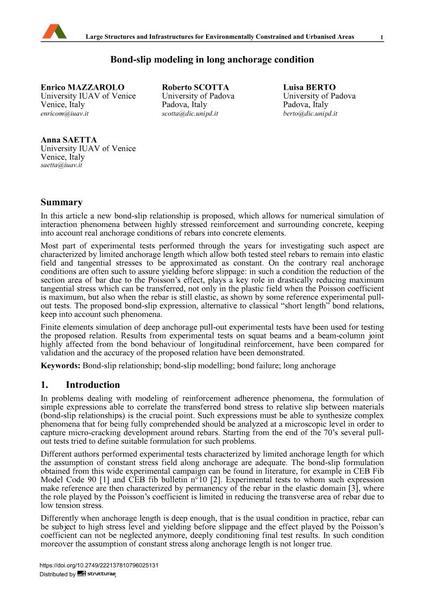Bond-slip modeling in long anchorage condition

|
|
|||||||||||
Bibliografische Angaben
| Autor(en): |
Enrico Mazzarolo
Roberto Scotta Luisa Berto Anna Saetta |
||||
|---|---|---|---|---|---|
| Medium: | Tagungsbeitrag | ||||
| Sprache(n): | Englisch | ||||
| Tagung: | IABSE Symposium: Large Structures and Infrastructures for Environmentally Constrained and Urbanised Areas, Venice, Italy, 22-24 September 2010 | ||||
| Veröffentlicht in: | IABSE Symposium Venice 2010 | ||||
|
|||||
| Seite(n): | 410-411 | ||||
| Anzahl der Seiten (im PDF): | 8 | ||||
| Jahr: | 2010 | ||||
| DOI: | 10.2749/222137810796025131 | ||||
| Abstrakt: |
In this article a new bond-slip relationship is proposed, which allows for numerical simulation of interaction phenomena between highly stressed reinforcement and surrounding concrete, keeping into account real anchorage conditions of rebars into concrete elements. Most part of experimental tests performed through the years for investigating such aspect are characterized by limited anchorage length which allow both tested steel rebars to remain into elastic field and tangential stresses to be approximated as constant. On the contrary real anchorage conditions are often such to assure yielding before slippage: in such a condition the reduction of the section area of bar due to the Poisson’s effect, plays a key role in drastically reducing maximum tangential stress which can be transferred, not only in the plastic field when the Poisson coefficient is maximum, but also when the rebar is still elastic, as shown by some reference experimental pull- out tests. The proposed bond-slip expression, alternative to classical “short length” bond relations, keep into account such phenomena. Finite elements simulation of deep anchorage pull-out experimental tests have been used for testing the proposed relation. Results from experimental tests on squat beams and a beam-column joint highly affected from the bond behaviour of longitudinal reinforcement, have been compared for validation and the accuracy of the proposed relation have been demonstrated. |
||||
